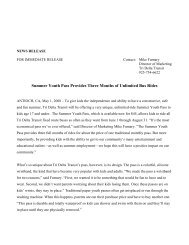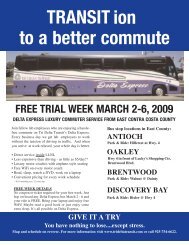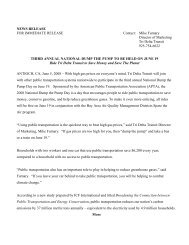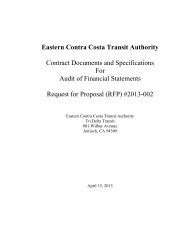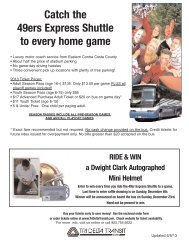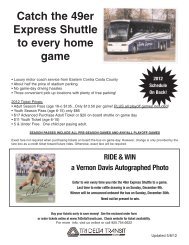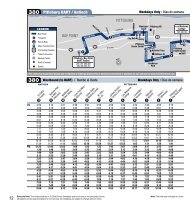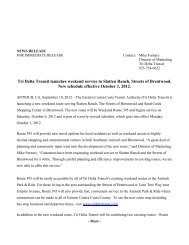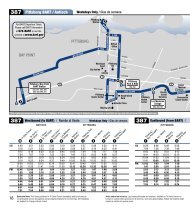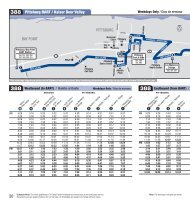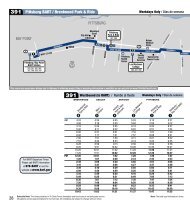to view Short Range Transit Plan FY 2007/2008 - Tri Delta Transit
to view Short Range Transit Plan FY 2007/2008 - Tri Delta Transit
to view Short Range Transit Plan FY 2007/2008 - Tri Delta Transit
You also want an ePaper? Increase the reach of your titles
YUMPU automatically turns print PDFs into web optimized ePapers that Google loves.
Each completed survey provides information regarding one distinct“linked” trip. A “linked trip” represents a complete journey that mayhave involved use of several distinct modes of travel between aperson’s origin and final destination. For example, someone may drivefrom home <strong>to</strong> a park & ride lot, transfer <strong>to</strong> a bus <strong>to</strong> BART, and thentake BART <strong>to</strong> their final destination. Each trip segment is a distinct“unlinked” trip, but the entire journey is one linked trip.Respondents were also asked if the trip they were being surveyedabout was one direction of a round trip, but details regarding the“second” (return) part of the trip were not collected. All <strong>Tri</strong> <strong>Delta</strong><strong>Transit</strong> routes were sampled approximately in proportion <strong>to</strong> their shareof <strong>to</strong>tal system patronage. Not all respondents answered all questions,so responses <strong>to</strong> a particular question may not add up <strong>to</strong> the <strong>to</strong>talnumber of surveys collected.The results of the survey provided empirical confirmation ofassumptions that ECCTA staff has been using for some time based ontheir daily observations and work on the <strong>Tri</strong> <strong>Delta</strong> <strong>Transit</strong> system.None of the data was significantly different from the concepts that staffhad already developed through observation. There was one surprisingdicho<strong>to</strong>my in the responses: While less than 20% of respondents wereusing <strong>Tri</strong> <strong>Delta</strong> <strong>Transit</strong> buses <strong>to</strong> get <strong>to</strong> or come from the existing BARTstation (I), 81% of patrons responded that that they would use eBARTif and when that service materializes.A composite profile of a <strong>Tri</strong> <strong>Delta</strong> <strong>Transit</strong> rider can be summarized fromthese survey results. The “average” rider would be:• Between twelve and thirty years old.• Is transit dependent with limited access <strong>to</strong> an au<strong>to</strong>mobile.• Lives in a low <strong>to</strong> very low income household.• Generally pays cash when riding the bus.• Regards their ethnicity as non-white.The survey also shows that most <strong>Tri</strong> <strong>Delta</strong> <strong>Transit</strong> patrons:• Begin and end their trips by bus within East County.• Make their trips without transferring between bus routes.• Use <strong>Tri</strong> <strong>Delta</strong> <strong>Transit</strong> buses for round trips.• Walk <strong>to</strong> and from the bus.The number of surveys collected on each route was proportional <strong>to</strong>each route’s share of <strong>to</strong>tal ridership, (Figures 3.11 and 3.12).49




